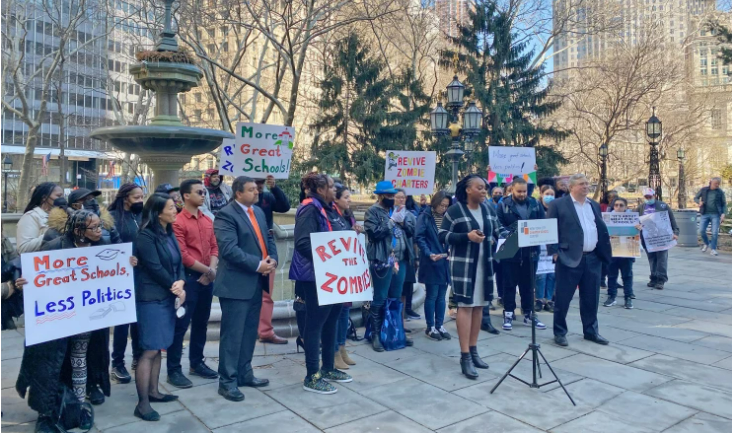
Last week, the Biden administration proposed new rules for its start-up grant program for charter schools. If adopted, the rules would make it tougher for those seeking to open new charter schools, which are publicly funded by privately managed enterprises.
The biggest proposed change would affect for-profit charter companies that run charter schools, making them ineligible for funding if they manage entire operations. Some proposed charter school changes, including this one, have drawn opposition from education choice advocates, including the National Alliance for Public Charter Schools.
For perspective on the proposed changes, reimaginED Senior Writer Lisa Buie turned to Michael Petrilli, president of the Thomas B. Fordham Institute and a supporter of education choice. Answers have been edited for brevity and clarity.
reimaginED: Please give us a broad overview of these new rules. What do they entail?
Petrilli: These are proposed regulations for three of the largest federal charter school grant programs. The grants support the start-up and replication of high-quality charter schools; the money goes either to state entities, charter networks, or individual schools (in states without a federal grant). These rules establish new priorities for the programs, and most critical, introduce new application requirements that go far beyond the statute and could severely limit the number of schools that receive grants.
reimaginED: Why are these rules being proposed, and why now?
Petrilli: The generous answer is that the Biden Administration is trying to make good on its campaign promises. A related, but less generous interpretation, is that the administration is repaying its debt to the teachers’ unions and other reform opponents. It’s telling, for instance, that charter opponent Carol Burris expressed enthusiasm for the proposed regulations in a recent Washington Post article.
reimaginED: Are the proposed rules aimed at all charter schools or certain ones, such as those managed by for-profit companies?
Petrilli: Both. Some pertain to all charter schools, and others are targeted at those managed by for-profit companies. Most analysts believe that the rules, if adopted, would make it virtually impossible for schools managed by for-profit companies to receive federal start-up grants going forward.
reimaginED: If schools managed by for-profits are producing favorable educational results, why not reward rather than penalize them for those results?
Petrilli: Good question! The program is already geared toward providing support to schools that show promise of getting great results (for start-up grants) or have already demonstrated great results (for replication grants). That’s what should matter, not how a school manages its affairs. But, alas, the far left is on a rampage on for-profit companies, and that is reflected here.
reimaginED: Do the rules also include provisions that make it more difficult for local non-profits to qualify for funding?
Petrilli: Absolutely. Indeed, it will likely be “mom and pop,” community-based schools that struggle the most to receive funding under these proposed regulations. That’s because the rules add an enormous amount of complexity to the process, which will be hard for small entities to handle.
But the worst part of the proposed regulations applies to everyone: a new requirement for a “community impact analysis.” That’s a euphemism for the union’s concern that charter schools will take kids and money away from traditional public schools. In particular, note this language: “Charter school must provide evidence that demonstrates that the number of charter schools proposed to be opened, replicated or expanded … does not exceed the number of public schools needed to accommodate the demand in the community.”
By this logic, new charter schools would only be allowed in communities with rising enrollment – which is almost nowhere right now. In the wake of the pandemic, and the baby bust, enrollment is flat or declining almost everywhere. So, this would stop charter growth in its tracks.
Never mind that rising charter enrollment has a positive impact on kids in traditional public schools and that charters don’t actually hurt districts financially. The question shouldn’t be whether there are enough schools, or seats, to serve students, but whether there are enough high-quality schools and seats to serve all students, especially those from disadvantaged backgrounds. The answer in virtually every community in the country is “No.” These rules would ignore that fact.
reimaginED: President Biden and other Democrats used to support charter schools as a way to help level the playing field for economically disadvantaged students who wanted a way out of their low-rated zoned district schools. What happened to change that?
Petrilli: Politics. What we’re seeing is the impact of the Democratic Party moving left on a host of issues, including education. It’s certainly nothing about the charter school movement itself, which has become higher performing over time, especially in cities.
reimaginED: What changes, if any, would be welcomed by charter schools and those who support education choice?
Petrilli: For starters, the language I quoted above needs to be struck. There’s nothing in federal law indicating that charter schools should launch only in neighborhoods without flat or declining enrollment, and neither should there be anything in federal regulations saying so.
Second, the new regulations around for-profit schools should be revised to focus on results instead of tax-status.
And third, the rules in general should be pared back and simplified, so as not to create barriers of entry for community-based schools.
reimaginED: How significantly would these changes, if adopted, affect the ability to expand education choice via charter schools? Do most start-ups depend on these grants?
Petrilli: Almost half of the existing 7,000 charter schools in the country received federal start-up grants at one point. So, these grants are extremely important, especially for community-based groups without access to philanthropic support. If these rules go through, it’s hard to imagine many applicants qualifying for support. That will leave hundreds of millions of federal dollars wasted and will make a huge dent in charter school growth.



[…] This article originally appeared at reimaginED. […]